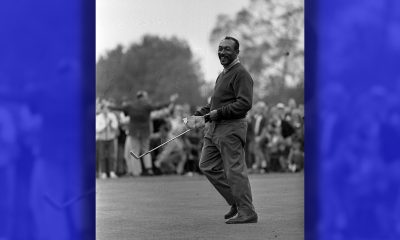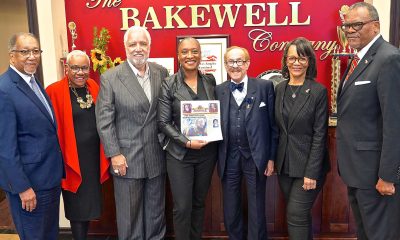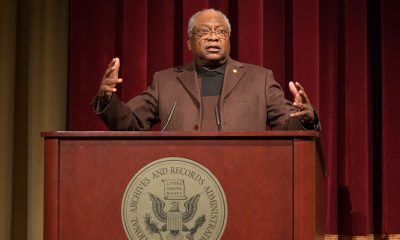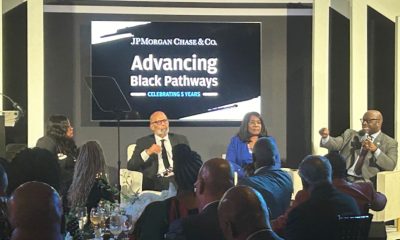Black History
Antioch Missionary Baptist Church, 1866 – 2019
HOUSTON FORWARD TIMES — The historic Antioch Missionary Baptist Church, will celebrate 153 years of ministry and service to the community
By Jeffery L. Boney
As we celebrate Black History Month during the month of February, it is fitting that the Forward Times highlights one of Houston’s oldest Black institutions.
This upcoming Sunday, February 24, 2019, the historic Antioch Missionary Baptist Church, will celebrate 153 years of ministry and service to the community, and the entire Greater Houston will have an opportunity to participate in this grand occasion. Antioch is located near downtown Houston at 500 Clay Street. Parking validation tickets will be available for those who attend.
Antioch’s new Senior Pastor, John F. Johnson, has invited Rev. Manson B. Johnson of Holman Street Baptist Church to serve as the guest minister for the scheduled 4:00 pm worship service. Rev. Anthony Macbeth and the United Praise Chorale will lead the praise and worship, and there will be a reception of fellowship immediately following the anniversary celebration at the church. Everyone is being encouraged to wear the Antioch Missionary Baptist Church colors of red, gold, or a combination of the two.
In January of 1866 – seven months after slaves were freed in Texas on June 19, 1865 – a small group of formerly enslaved people of African descent organized the first African American Baptist Church in Houston, which is now known as Antioch Missionary Baptist Church.
Those former enslaved descendants of Africa organized that church with the assistance of First Baptist Church and several missionaries. After initially holding worship services at First Baptist Church and at German Baptist Church, those formerly enslaved Blacks began holding their worship services on Buffalo Bayou in a “Brush Arbor”, and later moved their worship services to “Baptist Hill,” located at Rusk and Bagby. They remained at “Baptist Hill” until they were able to purchase another site location.
Starting off, worship services were conducted by various ministers who traveled to different locations at stated times. However, in 1868, one of the members of Antioch, John Henry “Jack” Yates, was ordained at the first Association meeting that was held for the African American Baptist Churches, and after that first National Baptist Convention, the Rev. Jack Yates was installed as the first-ever pastor of Antioch Missionary Baptist Church.
As the membership of Antioch grew, and as additional space was needed, Rev. Yates led the church to purchase its current site and to build a brick structure. The church, located in the center of Freedman’s Town, was the center of activity for the African American community. It was the first brick structure built in the city of Houston, and it was the first one owned by African Americans in the city. Antioch provided formerly enslaved people of African descent with opportunities to not only learn about God, but the church also provided ministries to help them develop educationally, economically and socially.
The first educational opportunity for formerly enslaved people of African descent began at Antioch, as Rev. Yates began the Baptist Academy with the help of two missionaries. The Baptist Academy taught Black people basic fundamentals such as reading, writing and arithmetic. In addition to that, Antioch was instrumental in teaching Blacks various trades, which enabled Black men and women to start their own businesses. The Baptist Academy later became known as Houston College, which was the forerunner of Texas Southern University (TSU).
Other major initiatives that were strongly encouraged and supported at Antioch included economic development and recreational activities.
The Old Landmark Baptist Association of Texas was organized at Antioch. Under Rev. Yates’ leadership, members were encouraged and assisted in buying property, owning homes and businesses. The historic Emancipation Park, in conjunction with Trinity Methodist Church, was purchased by Rev. Yates and a few other Blacks, in order to provide recreational activities and allow community celebrations for Blacks, such as Juneteenth.
With the vision and support of Rev. Yates and Antioch, the first African American college in the state of Texas, Bishop College, was formed. Just as they did then, Antioch’s congregation and leaders continue to provide needed and vital services to the Houston community.
The entire community is being invited out to attend this historic church and event during the Black History Month. For additional information, please call the Antioch Missionary Baptist Church office at 713.652.0738 or visit www.ambchouston.org.
This article originally appeared in the Houston Forward Times.
Activism
Oakland Post: Week of April 17 – 23, 2024
The printed Weekly Edition of the Oakland Post: Week of April 17 – 23, 2024

To enlarge your view of this issue, use the slider, magnifying glass icon or full page icon in the lower right corner of the browser window. ![]()
Black History
Matthew Henson: Explorer Extraordinaire
Matthew Henson, a trailblazing explorer who overcame countless obstacles to leave an incredible mark on history. Born on August 8, 1866, in Charles County, Maryland, his journey is a testament to the power of determination and the spirit of adventure.

By Tamara Shiloh
Matthew Henson, a trailblazing explorer who overcame countless obstacles to leave an incredible mark on history. Born on August 8, 1866, in Charles County, Maryland, his journey is a testament to the power of determination and the spirit of adventure.
Henson’s life began amidst the backdrop of post-Civil War America, where opportunities for African Americans were scarce. From a young age, he possessed an insatiable curiosity about the world beyond his small town. At the age of 12, he embarked on a journey that would change the course of his life forever when he joined a merchant ship as a cabin boy.
His most famous expedition was his journey to the Arctic with renowned explorer Robert E. Peary. In 1887, Henson joined Peary’s crew as a seaman and quickly proved himself to be invaluable with his skills as a navigator and craftsman. Over the course of several expeditions, Matthew endured extreme cold, treacherous terrain, and grueling conditions as he and Peary sought to reach the elusive North Pole.
In 1908–09, Peary set out on his eighth attempt to reach the North Pole. It was a big expedition, with Peary planning to leave supplies along the way. When he and Henson boarded their ship, the Roosevelt, leaving Greenland on August 18, 1909, they were joined by a large group. This included 22 Inuit men, 17 Inuit women, 10 children, 246 dogs, 70 tons of whale meat, blubber from 50 walruses, hunting gear, and tons of coal.
In February, Henson and Peary left their anchored ship at Ellesmere Island’s Cape Sheridan, along with the Inuit men and 130 dogs. They worked together to set up a trail and supplies along the way to the Pole.
Peary picked Henson and four Inuit people to join him in the final push to the Pole. However, before they reached their destination, Peary couldn’t walk anymore and had to ride in a dog sled. He sent Henson ahead to scout the way. In a later interview with a newspaper, Henson recalled being in the lead and realizing they had gone too far. The group turned back, and Henson noticed his footprints helped guide them to their destination. At that location, Henson planted the American flag.
Henson’s legacy extends far beyond his expeditions to the Arctic. He shattered racial barriers in the world of exploration and inspired countless individuals, regardless of race, to dream big and pursue their passions. In 1937, he was finally recognized for his achievements when he was inducted into The Explorers Club, an organization dedicated to promoting scientific exploration and field research.
Matthew Henson died in the Bronx, New York, on March 9, 1955, at the age of 88.
Art
Marin County: A Snapshot of California’s Black History Is on Display
The Marin County Office of Education, located at 1111 Las Gallinas Ave in San Rafael, will host the extraordinary exhibit, “The Legacy of Marin City: A California Black History Story (1942-1960),” from Feb. 1 to May 31, 2024. The interactive, historical, and immersive exhibit featuring memorabilia from Black shipyard workers who migrated from the South to the West Coast to work at the Marinship shipyard will provide an enriching experience for students and school staff. Community organizations will also be invited to tour the exhibit.

By Post Staff
The Marin County Office of Education, located at 1111 Las Gallinas Ave in San Rafael, will host the extraordinary exhibit, “The Legacy of Marin City: A California Black History Story (1942-1960),” from Feb. 1 to May 31, 2024.
The interactive, historical, and immersive exhibit featuring memorabilia from Black shipyard workers who migrated from the South to the West Coast to work at the Marinship shipyard will provide an enriching experience for students and school staff. Community organizations will also be invited to tour the exhibit.
All will have the opportunity to visit and be guided by its curator Felecia Gaston.
The exhibit will include photographs, articles and artifacts about the Black experience in Marin City from 1942 to 1960 from the Felecia Gaston Collection, the Anne T. Kent California Room Collection, The Ruth Marion and Pirkle Jones Collection, The Bancroft Library, and the Daniel Ruark Collection.
It also features contemporary original artwork by Chuck D of the Rock and Roll Hall of Fame group Public Enemy, clay sculptures by San Francisco-based artist Kaytea Petro, and art pieces made by Marin City youth in collaboration with Lynn Sondag, Associate Professor of Art at Dominican University of California.
The exhibit explores how Marin City residents endured housing inequities over the years and captures the history of plans to remove Black residents from the area after World War II. Throughout, it embodies the spirit of survival and endurance that emboldened the people who made Marin City home.
Felecia Gaston is the author of the commemorative book, ‘A Brand New Start…This is Home: The Story of World War II Marinship and the Legacy of Marin City.’ Thanks to the generous contribution of benefactors, a set of Felecia’s book will be placed in every public elementary, middle, and high school library in Marin.
In addition, educators and librarians at each school will have the opportunity to engage with Felecia in a review of best practices for utilizing the valuable primary sources within the book.
“Our goal is to provide students with the opportunity to learn from these significant and historical contributions to Marin County, California, and the United States,” said John Carroll, Marin County Superintendent of Schools.
“By engaging with Felecia’s book and then visiting the exhibit, students will be able to further connect their knowledge and gain a deeper understanding of this significant historical period,” Carroll continued.
Felecia Gaston adds, “The Marin County Office of Education’s decision to bring the Marin City Historical Traveling Exhibit and publication, ‘A Brand New Start…This is Home’ to young students is intentional and plays a substantial role in the educational world. It is imperative that our community knows the contributions of Marin City Black residents to Marin County. Our youth are best placed to lead this transformation.”
The Marin County Office of Education will host an Open House Reception of the exhibit’s debut on Feb. 1 from 4 p.m. – 6 p.m.. All school staff, educators, librarians, and community members are encouraged to attend to preview the exhibit and connect with Felecia Gaston. To contact Gaston, email MarinCityLegacy@marinschools.org
-

 Activism4 weeks ago
Activism4 weeks agoOakland Post: Week of March 27 – April 2, 2024
-

 #NNPA BlackPress4 weeks ago
#NNPA BlackPress4 weeks agoCOMMENTARY: D.C. Crime Bill Fails to Address Root Causes of Violence and Incarceration
-

 #NNPA BlackPress4 weeks ago
#NNPA BlackPress4 weeks agoFrom Raids to Revelations: The Dark Turn in Sean ‘Diddy’ Combs’ Saga
-

 #NNPA BlackPress4 weeks ago
#NNPA BlackPress4 weeks agoCOMMENTARY: Lady Day and The Lights!
-

 #NNPA BlackPress4 weeks ago
#NNPA BlackPress4 weeks agoMayor, City Council President React to May 31 Closing of Birmingham-Southern College
-

 #NNPA BlackPress4 weeks ago
#NNPA BlackPress4 weeks agoBaltimore Key Bridge Catastrophe: A City’s Heartbreak and a Nation’s Alarm
-

 #NNPA BlackPress4 weeks ago
#NNPA BlackPress4 weeks agoBaltimore’s Key Bridge Struck by Ship, Collapses into Water
-

 #NNPA BlackPress4 weeks ago
#NNPA BlackPress4 weeks agoBeloved Actor and Activist Louis Cameron Gossett Jr. Dies at 87





















































